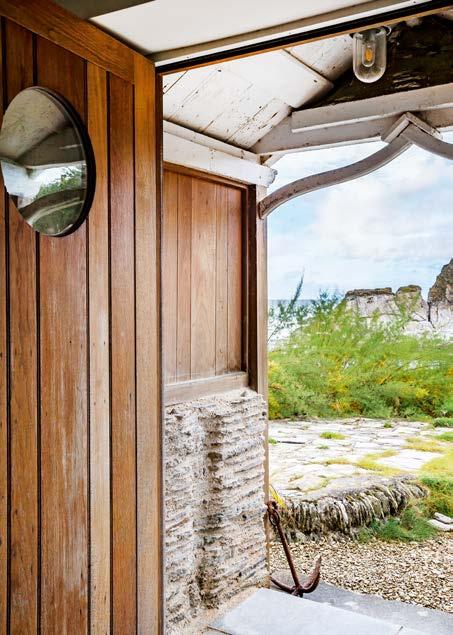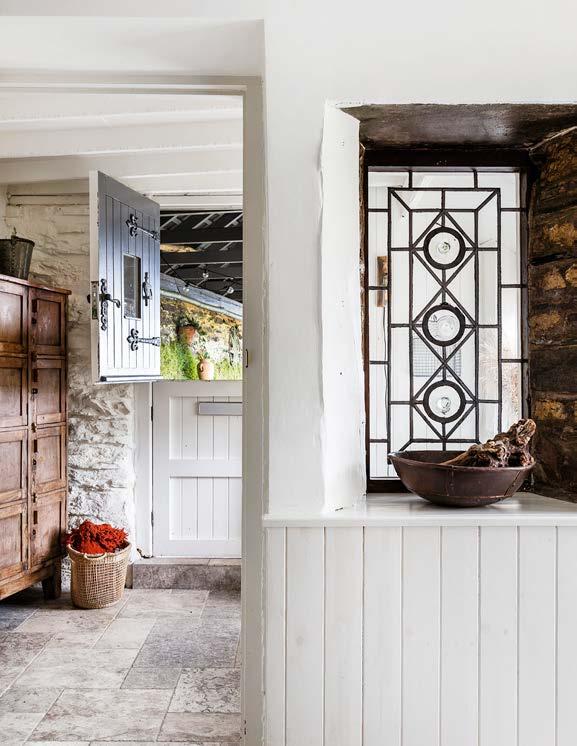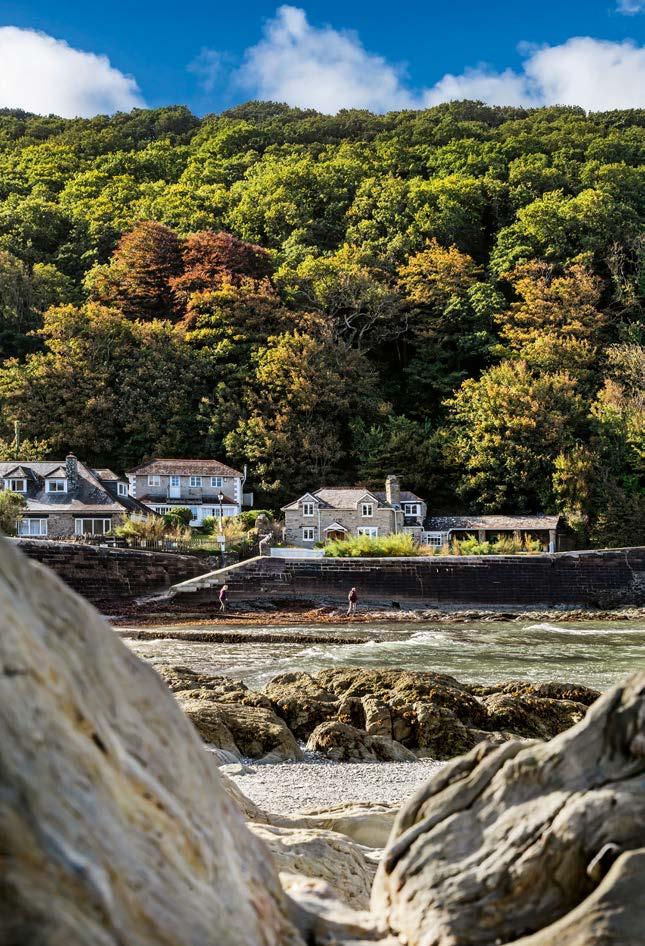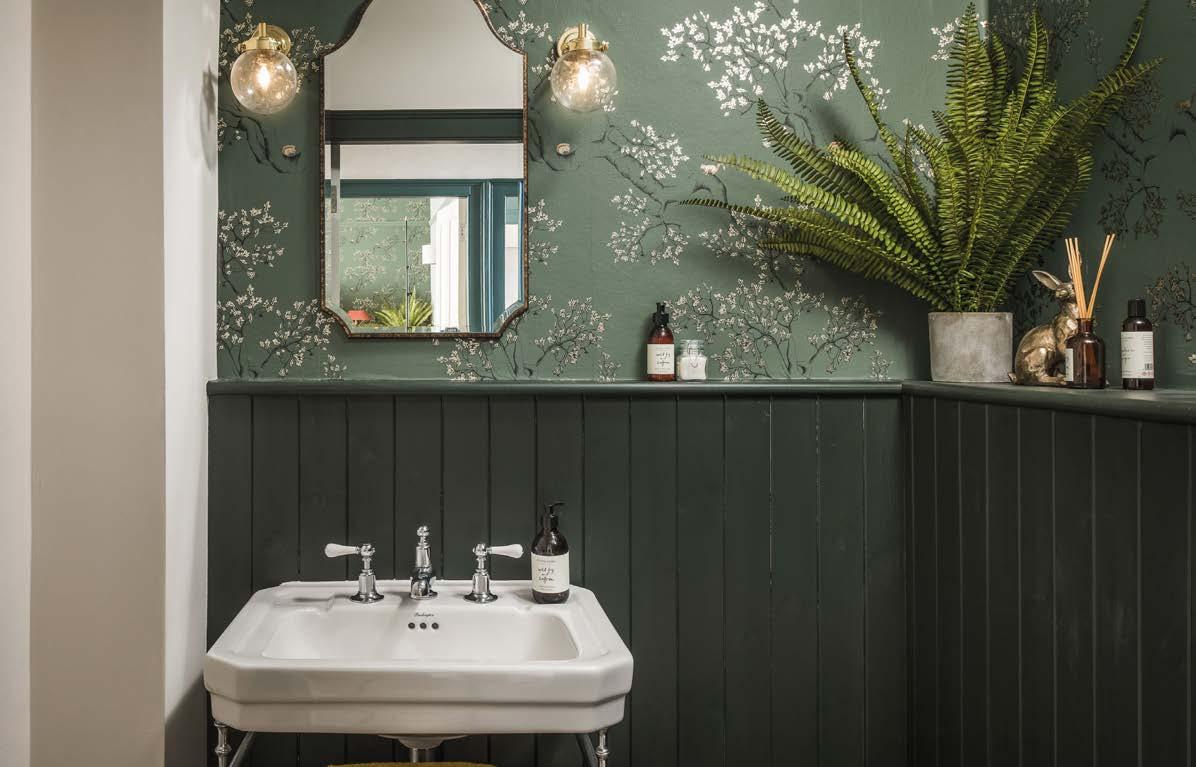
5 minute read
TREASURE TROVE
This 17th-century stone cottage, tucked into Devon’s rugged northern coastline, has a long and intriguing history which its owners have delighted in discovering
ABOVE Simple blinds made from Designers Guild Alabaster linen filter the light and frame the view. The unusual double-arch screen apparently came from a Spanish Armada ship which was wrecked on the coast.
LEFT A new front door with a porthole lets in more light and offers an intriguing perspective of the rugged coastal scene beyond.

As Jane Banbury takes in the ever-shifting view of sea and sky through the bay window of the coastal home in North Devon that she shares with husband John, and daughters Ellie, 10, and Bella, seven, she says, “I could spend hours here, just watching the world slowly go by. This place has a sense of yesteryear – life seems much simpler somehow.”
Indeed, Lee Bay, tucked into the rugged coastline, seems part of a bygone age. The village itself – two miles west of busy Ilfracombe – is set in a deep combe, with a cluster of traditional buildings forming its hub. From there, a narrow path meanders to the bay, a rocky cove sheltered by wooded cliffs soaring up behind it. Not much happens here these days, it seems. Beachcombers wander along the small sandy beach as dogs scamper into the water and youngsters scramble among the crystal-clear rock pools. Yet, this peaceful scene belies a much more dramatic past, for this is a stretch of coastline famed for smuggling – a thread of history which, as the family have discovered, has a direct tie with their own much-loved home.
The hooded brick chimney breast was constructed by previous owners over 75 years ago and marries beautifully with the original walls which are 45cm thick in parts. An aged conker-brown leather chair from Tallboy Interiors picks up on the brickwork tones. The industrial-style light behind it is from Frezoli Lighting.
Early one morning in 1789, a stranger rode down the quiet lane leading to the village carrying his diminutive wife in the saddle with him. This was Hannibal Richards, a giant of a man at six and a half feet, with a mane of wild black hair, and a fierce demeanour. He was a renowned smuggler who had fled Cornwall to escape the authorities, seeking to disappear in this remote corner of the neighbouring county. Soon, however, he was up to his old tricks, bringing cargoes of precious lace, tobacco and brandy from France, and storing his contraband in all manner of hiding places.
The Banburys’ pretty 17th-century cottage, perched on the edge of the bay, was to play its part. At night, as Hannibal crouched in his boat in the bay, an accomplice would signal to him from an upstairs window when the coast was clear, so he could come safely ashore and store his cache, often in the hillside directly behind the cottage. “It seems extraordinary to think of all that happening here,” reflects Jane.
ABOVE The kitchen was in situ when Jane and John bought the cottage. They have customised the units with black beeswax handles to match the updated window furniture by From The Anvil. RIGHT The boot room with its set of old school lockers has a stable door leading to the covered terrace outside.

The dining area features a new floor from Mandarin Stone extending through to the kitchen and boot room. An eclectic gallery of paintings and portraits create an interesting display.
ABOVE Tongueand-groove cladding lends a shipshape feel to this bedroom, underpinned by uninterrupted sea views. The casual linen blinds used throughout have additional blackout lining in the three bedrooms.
LEFT The main bathroom is a showstopper thanks to the magnificent freestanding bath from Vintage France Design, offset with a marble basin found on Etsy which sits on an old chest of drawers.

“I often think of Hannibal stealing into the cottage to plot and plan, no doubt stooping to avoid hitting his head on the beams. On stormy nights, when you can hear the waves crashing on the rocks, it’s not hard to imagine how it must have been during that time.” Eventually, the days of smuggling came to an end –Hannibal Richards is buried in Ilfracombe churchyard – and this northern stretch of the county evolved into a destination for genteel Victorians who came for the sea air. The house soon enjoyed a gentler existence as a tearoom and for many decades served traditional Devonshire fare.
By the time the Banburys came to view the cottage in the spring of 2018, it had been returned to its status as a home. Immediately inside was what would have been the original living space, leading to a much later extension at the back which incorporated a kitchen, dining area and boot room. Upstairs, four bedrooms and a bathroom were tucked into the eaves. Nevertheless, it was, as Jane recalls, somehow lacking in soul and character. “Although we had no doubt it was very special, we knew it would need some investment to realise its full potential,” she says.
The couple had long loved this part of Devon but were not yet in a position to relocate lock, stock and barrel from their home in Kent, with busy careers and their young daughters happily settled in school. “We had to ask ourselves if we should pour our love and money into this little place and make it the best it can be, even though we can’t be here all the time yet,” Jane says. But their hearts had been won over: “There was no going back,” she says.
As soon as the house was theirs, work to renovate it began in earnest. “We didn’t need to make any major alterations, so planned a tight schedule – just six months – but felt confident that we could pull it off with our trusted team of builders,” Jane explains. The house is Grade II listed and in a conservation area, so there were certain restrictions. “We took great care to preserve as many original features as possible, though we were able to turn one of the bedrooms into a really comfortable bathroom instead,” she points out.

After tackling the basics – upgrading the electric and heating systems, along with replacing the concrete pointing on the exterior brickwork with lime mortar – the decor could be addressed. Jane’s vision was very clear. “I didn’t want the cottage’s character to be overshadowed by a busy or complicated scheme, so it is very pared back and consistent throughout. We’ve used white as a backdrop, overlaid with different textures, natural materials and tones,” she explains.

Most importantly, the couple wanted the house to have a strong sense of place, but without the usual seaside clichés. Instead, its provenance has been subtly alluded to with authentic seafaring ephemera, artwork and beachcombing finds such as driftwood, pebbles and shells, along with timeworn pieces which the couple have picked up in antique markets and vintage stores to reference the cottage’s long history.

The overall effect is one of warm informality, with a refreshing take on coastal style. “The best thing is that it feels like home as soon as you step inside,” Jane says. “So much has happened here over the centuries, but we think Hannibal would still recognise it as the cottage he knew centuries ago – though it’s probably safe to say he would find it a lot more comfortable these days.” ■











